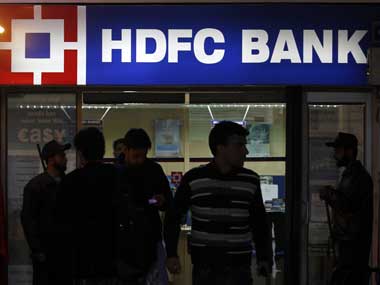Sometimes, it is good to not think of shares as shares. Warren Buffett, the world’s most famous investor, doesn’t think of them that way. He sees them as an entitlement to a company’s future revenue streams, and the more predictable the revenue stream looks, the more he likes such shares.
Of course, if a company’s profits oscillate dramatically from plus to minus from year to year, you can’t think of its shares as anything more than an invitation to the casino.
[caption id=“attachment_111635” align=“alignleft” width=“380” caption=“When net profits are compounding 50 percent faster than share price growth, it can mean only one thing: there is room to gain. Reuters”]  [/caption]
But HDFC Bank is different. It is the closest thing you can get to an annuity scheme - like a regular monthly pension - in the share market today.
Consider the stats:
• Over the last 26 quarters, net profit growth has never fallen below 30 percent. The average for the quarters is 34.2 percent, and in the latest quarter (30 September 2011) the net profit growth is 31.4 percent. So, there.
• The compound annual growth rate in net profits is 29.68 percent - which confirms the previous figure.
• Between 2006 and now, the share price has been compounding at the rate of 19.45 percent annually. Which means, even excluding dividends and share splits, you can assume tax-free long-term capital gains growth of nearly 20 percent a year.
• And here’s the clincher. When net profits are compounding 50 percent faster than share price growth, it can mean only one thing: there is room to gain. And even if a bear market intervenes, you don’t lose much.
• Assuming the share continues to compound at the same rate for the next five years, the HDFC Bank share should be at Rs 1,184 by 2016.
[caption id=“attachment_111680” align=“aligncenter” width=“410” caption=“Source: Ace Equity”]  [/caption]
The accompanying table above shows you quarterly net profit growth since the first quarter of 2006 and the latest quarter.
The chart below tells you where the share price could be in various years between now and 2016, assuming the share price continues to compound at 19.45 percent annually.
But here’s the catch: the share markets are not going to rise so predictably. So what if HDFC Bank does not follow the path shown by our chart below?
The chart, in fact, should cue you on when to buy or sell the HDFC Bank share.
In periods when the share price falls significantly below the trend line, you can accumulate the share. And vice-versa.
[caption id=“attachment_111671” align=“aligncenter” width=“516” caption=“Source:Ace Equity”]  [/caption]
This way your gains will exceed that shown by the trend line over the same number of years. Of course, you can just buy now and sit tight. As long as the bank compounds its profits at the same rate, you have little to fear.
(Disclaimer: Firstpost is bringing you this investment idea in good faith. It is always advisable to check with your investment advisor or broker before investing. Firstpost will not take responsibility for any losses incurred by taking this advice. The author of this post does not own any shares of HDFC Bank at the time of writing.)


)
)
)
)
)
)
)
)
)



